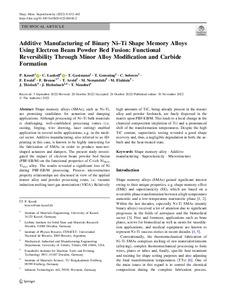| dc.date.accessioned | 2023-01-27T17:15:51Z | |
| dc.date.available | 2023-01-27T17:15:51Z | |
| dc.date.issued | 2022-11-30 | |
| dc.identifier | doi:10.17170/kobra-202301057316 | |
| dc.identifier.uri | http://hdl.handle.net/123456789/14391 | |
| dc.description.sponsorship | Gefördert im Rahmen des Projekts DEAL | ger |
| dc.language.iso | eng | eng |
| dc.rights | Namensnennung 4.0 International | * |
| dc.rights.uri | http://creativecommons.org/licenses/by/4.0/ | * |
| dc.subject | shape memory alloy | eng |
| dc.subject | additive manufacturing | eng |
| dc.subject | superelasticity | eng |
| dc.subject | microstructure | eng |
| dc.subject.ddc | 660 | |
| dc.title | Additive Manufacturing of Binary Ni–Ti Shape Memory Alloys Using Electron Beam Powder Bed Fusion: Functional Reversibility Through Minor Alloy Modification and Carbide Formation | eng |
| dc.type | Aufsatz | |
| dcterms.abstract | Shape memory alloys (SMAs), such as Ni–Ti, are promising candidates for actuation and damping applications. Although processing of Ni–Ti bulk materials is challenging, well-established processing routes (i.e. casting, forging, wire drawing, laser cutting) enabled application in several niche applications, e.g. in the medical sector. Additive manufacturing, also referred to as 4D-printing in this case, is known to be highly interesting for the fabrication of SMAs in order to produce near-net-shaped actuators and dampers. The present study investigated the impact of electron beam powder bed fusion (PBF-EB/M) on the functional properties of C-rich Ni₅₀.₉Ti₄₉.₁ alloy. The results revealed a significant loss of Ni during PBF-EB/M processing. Process microstructure property relationships are discussed in view of the applied master alloy and powder processing route, i.e. vacuum induction-melting inert gas atomization (VIGA). Relatively high amounts of TiC, being already present in the master alloy and powder feedstock, are finely dispersed in the matrix upon PBF-EB/M. This leads to a local change in the chemical composition (depletion of Ti) and a pronounced shift of the transformation temperatures. Despite the high TiC content, superelastic testing revealed a good shape recovery and, thus, a negligible degradation in both, the as-built and the heat-treated state. | eng |
| dcterms.accessRights | open access | |
| dcterms.creator | Krooß, Philipp | |
| dcterms.creator | Lauhoff, Christian | |
| dcterms.creator | Gustmann, Tobias | |
| dcterms.creator | Gemming, Thomas | |
| dcterms.creator | Sobrero, Céscar E. | |
| dcterms.creator | Ewald, Felix Clemens | |
| dcterms.creator | Brenne, Florian | |
| dcterms.creator | Arold, Tizian | |
| dcterms.creator | Nematollahi, Mohammadreza | |
| dcterms.creator | Elahinia, Mohammad | |
| dcterms.creator | Thielsch, Juliane | |
| dcterms.creator | Hufenbach, Julia Kristin | |
| dcterms.creator | Niendorf, Thomas | |
| dc.relation.doi | doi:10.1007/s40830-022-00400-2 | |
| dc.relation.projectid | Project Number 398899207 | eng |
| dc.subject.swd | Memory-Legierung | ger |
| dc.subject.swd | Rapid Prototyping <Fertigung> | ger |
| dc.subject.swd | Pseudoelastizität | ger |
| dc.subject.swd | Mikrostruktur | ger |
| dc.subject.swd | Schmelzen | ger |
| dc.type.version | publishedVersion | |
| dcterms.source.identifier | eissn:2199-3858 | |
| dcterms.source.issue | Issue 4 | |
| dcterms.source.journal | Shape Memory and Superelasticity | eng |
| dcterms.source.pageinfo | 452-462 | |
| dcterms.source.volume | Volume 8 | |
| kup.iskup | false | |


